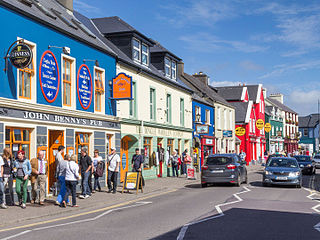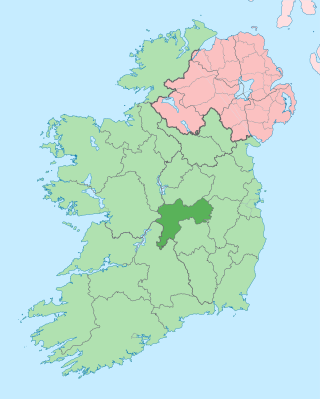
Dingle is a town in County Kerry, Ireland. The only town on the Dingle Peninsula, it sits on the Atlantic coast, about 50 kilometres (30 mi) southwest of Tralee and 71 kilometres (40 mi) northwest of Killarney.

County Offaly is a county in Ireland. It is part of the Eastern and Midland Region and the province of Leinster. It is named after the ancient Kingdom of Uí Failghe. It was formerly known as King's County, in honour of Philip II of Spain. Offaly County Council is the local authority for the county. The county population was 82,668 at the 2022 census.

Daingean, formerly Philipstown, named after King Philip II of Spain, is a small town in east County Offaly, Ireland. It is situated midway between the towns of Tullamore and Edenderry on the R402 regional road. The town of Daingean had a population, as of the 2016 census, of 1,077. It is the principal town of the Daingean Catholic Parish. The other main poles of this parish are Ballycommon, Kilclonfert and Cappincur.
Dempsey is a surname of Irish origin.
The kingdom of Uí Fháilghe, Uí Failge or Uíbh Fhailí was a Gaelic-Irish kingdom which existed to 1550, the name of which is preserved in the name of County Offaly, Ireland.
Events from the year 1556 in Ireland.
Philipstown in King's County was a constituency represented in the Irish House of Commons until 1800. The town was later renamed Daingean in 1922.
Ormond Lower is a barony in County Tipperary, Ireland. This geographical unit of land is one of 12 baronies in County Tipperary. Its chief town is Nenagh. The barony lies between Ormond Upper to the south-east and Owney and Arra to the south-west. As a "peninsula", it is surrounded on three sides by counties Galway and Offaly.
Ikerrin is a barony in County Tipperary, Ireland. This geographical unit of land is one of 12 baronies in County Tipperary. Its chief town is Roscrea. The barony lies between Eliogarty to the south and Ormond Upper to the west. As a "peninsula", it is surrounded on three sides by counties Offaly and Laois. The territory is currently administered by Tipperary County Council.

Eliogarty is a barony in County Tipperary, Ireland. This geographical unit of land is one of 12 baronies in County Tipperary. Its chief town is Thurles. The barony lies between Ikerrin to the north, Kilnamanagh Upper to the west, Middle Third to the south and County Kilkenny to the east. It is currently administered by Tipperary County Council.
Kevin Kilmurray was an Irish Gaelic footballer who played for his local club Daingean and at senior level for the Offaly county team from 1969 until 1980.
Events from the year 1557 in Ireland.
Fr. Patrick Dunne (1818–1900) was an Irish Roman Catholic priest who ministered in Australia.
Offaly West is a barony in County Kildare, Ireland.
Offaly East is a barony in County Kildare, Ireland.
Aghamore is a village in County Leitrim, Ireland

Coolestown is a barony in County Offaly, Ireland.

Lower Philipstown is a barony in County Offaly, Ireland.

The Settlement of Laois and Offaly 1556 was an Act of the Parliament of Ireland passed in 1556 which resulted in the creation of Queen's County and King's County in the midlands of Ireland, and the establishment of two shire towns at Maryborough (Portlaoise) and Philipstown (Daingean), named in honour of Queen Mary I and King Phillip II. The Act was the first Tudor attempt at plantation in Ireland and was designed to formally open up the area to English settlement.







